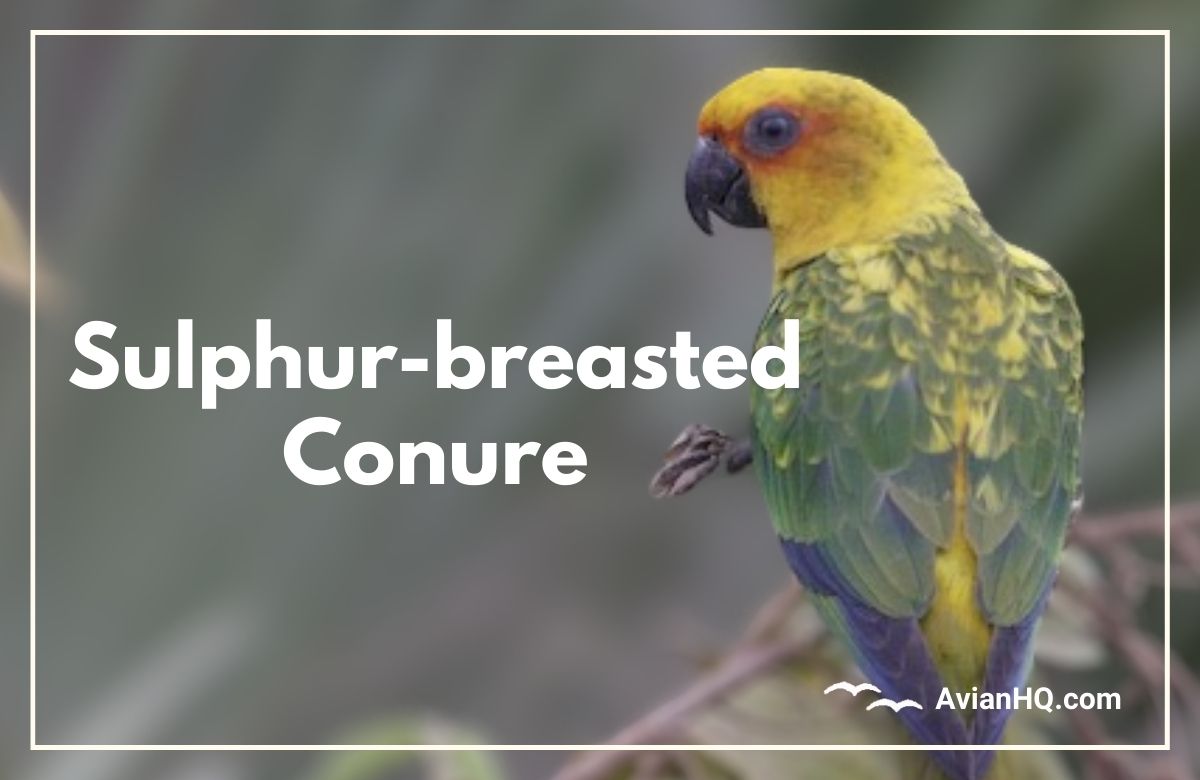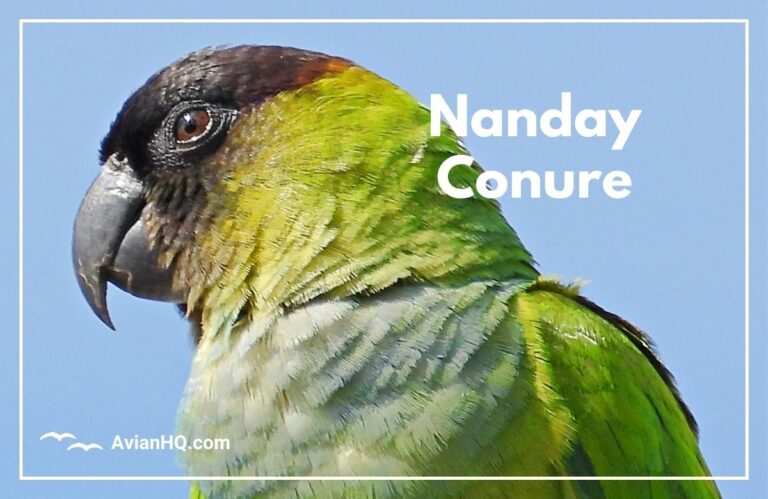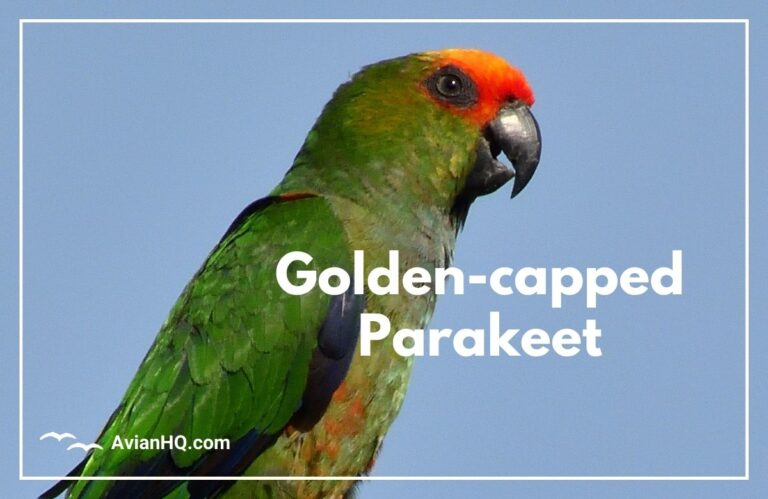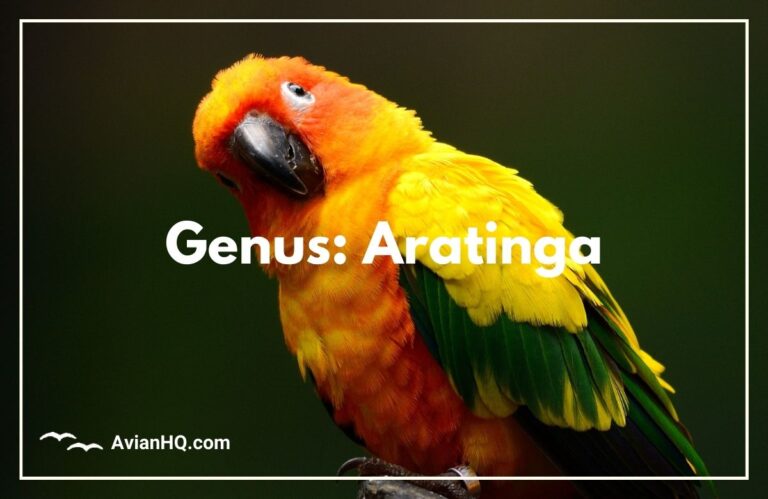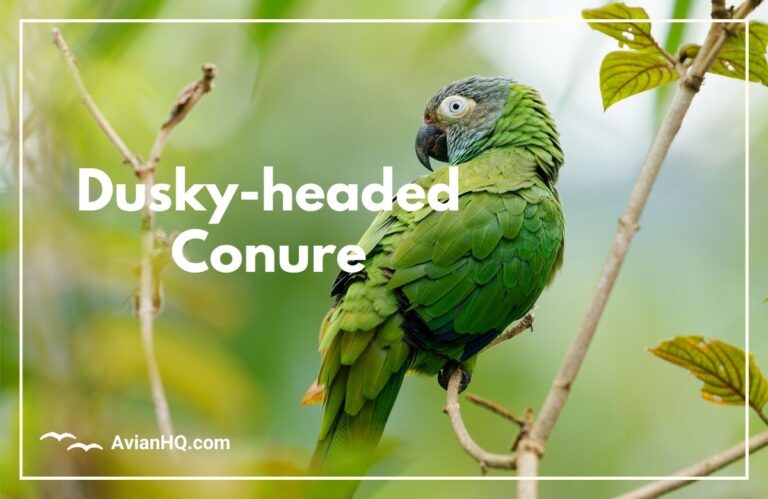Sulphur-breasted Conure (Aratinga maculata)
Have you ever seen a bright green parrot with a vibrant yellow chest flying through the trees? If so, you may have spotted the Sulphur-breasted Conure, a medium-small parrot native to Brazil. With its colorful plumage and social nature, this little parrot stands out in its rainforest home.
Measuring about 11 inches (28 cm) from beak to tail tip, the Sulphur-breasted Conure is one of the smaller conure species. But its personality makes up for its petite size! These parrots live in flocks of 10 to 30 birds, constantly calling and interacting with one another. They roost together at night and forage together by day, zipping through trees in search of fruits, seeds, and other tasty morsels.
The Sulphur-breasted Conure gets its name from the vibrant sulphur-yellow breast patch dotted with red spots. This lemon-yellow coloration contrasts sharply with the parrot’s overall bright green feathers. Other distinguishing features include white rings around its eyes, a horn-colored beak, and gray feet.
This species is native to east-central South America, inhabiting forests and woodlands across interior Brazil. It resides across a large swath of the country between the Amazon and drier interior habitats. Although still common in many regions, habitat loss does pose threats to Sulphur-breasted Conure populations in some areas.
History and Taxonomy
The Sulphur-breasted Conure has a relatively short scientific history, first entering the literature in the mid-19th century. Its classification has remained stable over the years, with no subspecies currently described. But scientists still have much to uncover about the evolutionary origins and genetic connectivity of different populations.
First Discovery
This species first became known to science in 1856 when it was formally described and named by French ornithologist Charles Lucien Bonaparte. He gave the parrot the binomial name Aratinga maculata, placing it in the Aratinga genus of small, long-tailed New World parrots.
Bonaparte collected the first specimens himself near the city of Pará in northern Brazil. But local peoples surely knew of the species long before European documentation. Indigenous groups have interacted with these birds across Brazil’s interior for generations.
Scientific Classification
From its initial description onward, scientists have consistently classified the Sulphur-breasted Conure in the genus Aratinga, within the larger parrot family Psittacidae. This grouping contains conures and macaws from Central and South America.
Some experts previously merged Aratinga with a few other parrot genera into an expanded Aratinga group. But more recent genetic studies led taxonomists to reinstate distinct genera. So this species again sits securely in the Aratinga genus today.
Subspecies and Distribution
The Sulphur-breasted Conure remains a monotypic species with no designated subspecies. But some geographic variation in size, shape, and color exists across scattered populations. For example, individuals in drier interior regions appear a bit smaller and paler overall.
Scientists have yet to fully study genetic connectivity and possible barriers to breeding between distant groups. Isolated inland populations may eventually prove distinct enough to warrant subspecies status pending more research. For now, all Sulphur-breasted Conures are considered a single species.
Physical Appearance
The vibrant coloration and distinctive markings of the Sulphur-breasted Conure make this species easily recognizable. Its bright plumage provides camouflage amidst lush greenery while allowing the birds to spot each other among forest vegetation.
Size and Weight
The Sulphur-breasted Conure averages about 11 inches (28 cm) long from the tip of its tail to the end of its beak. It typically weighs between 3.5-4 ounces (100-115 grams) on standing scales. So it ranks on the smaller end of conure species in the region.
Plumage Colors and Markings
This parrot lives up to its common name with lemon-yellow chest plumage dotted by scarlet spots. The yellow extends into a bright hind collar area around its nape. The remainder of the body and head appears predominantly grass green, allowing excellent camouflage within treetops.
Wing flight feathers bear yellow edging that shows up prominently during flight. Prominent white eye rings encircle its dark brown irises. The horn-colored beak coordinates well with gray feet upon close inspection.
Differences Between Populations
Few consistent distinctions occur among scattered populations, though occasional subtle differences arise. The green plumage of interior birds tends slightly duller and darker than those dwelling near the Amazon. Size averages a bit smaller away from humid forests as well.
But most coloration and patterning features remain fairly consistent across the wide range. No geographic variants currently warrant subspecies designation from taxonomists.
Facial Features
In addition to its bold eye rings, the Sulphur-breasted Conure has dark gray areas surrounding the eyes. The relatively short but sharp horn-colored beak suits its diet of seeds and nuts. Strong jaw muscles allow these birds to crack hard shells.
Bare patches of pale bluish skin occur around its eyes and beak base, in contrast to feathered areas. This exposes sensitive facial skin to sunlight, allowing synthesis of beneficial vitamin D.
Habitat and Distribution
The Sulphur-breasted Conure occupies a wide swath of interior Brazil, centered along the shifting transition zone between rainforest and drier wooded regions. It demonstrates a high degree of adaptability, thriving across several habitat types.
Native Range and Habitat
This species primarily inhabits forested areas and woodlands in eastern and central Brazil. Its range stretches from the Amazon Basin to the drier Caatinga and Cerrado ecosystems further south and east. It resides in a band encompassing much of Mato Grosso, Tocantins, Goiás, Minas Gerais, Bahia, and interior Maranhão and Pará states.
Both humid rainforests and seasonally dry forests occur within its broad territory. The Sulphur-breasted Conure exploits forest borders, clearings, plantations, and wooded savannas within this zone as well. So it occupies varied arboreal habitats, demonstrating flexibility.
Introduced Populations
Small feral populations have become established in scattered locations outside the native range following past escape or release of captive birds. Tiny breeding groups exist around cities in California, Florida, Hawaii, and possibly elsewhere. But most introduced populations remain extremely small and localized due to absence of suitable habitat and climate.
Elevation Range
Within its Brazilian stronghold, the Sulphur-breasted Conure typically occurs up to elevations of 3,300 feet (1,000 meters) in more mountainous areas. It resides closer to sea level across flatter interior terrain. So a wide vertical range allows exploitation of varied forest types and vegetation zones.
Diet and Feeding
The Sulphur-breasted Conure utilizes its sturdy beak and tongue to consume a diverse mix of seeds, fruits, flowers, and other nutritious plant material. It forages both high in the canopy and closer to the ground.
Overview of Diet
This species feeds on a wide variety of plant matter. It functions partly as a granivore, consuming seeds and grains. It also eats softer plant material such as fruits, buds, and flowers. Depending on food availability, the proportion of seeds versus vegetable matter fluctuates.
Common major food items include palm fruits, figs, maize kernels, and seeds of woody plants. Less frequently, these parrots may sample grasses, fungi, or arthropods for variation. Their strong jaws allow them to extract embedded seeds other birds cannot access. So they fill an important seed dispersal role for certain trees.
Feeding Behaviors
The Sulphur-breasted Conure often forages in small flocks of 6-12 individuals. Group feeding provides safety from predators and allows sharing of productive food sources. Flocks communicate vocally while efficiently stripping fruiting trees or raiding maize fields.
These social birds roost communally each night, then set out to feed after sunrise. After resting through the midday heat, they forage more prior to evening roosting. Their strong beaks and tongues are well-adapted to move and crack open seeds and fruit.
Breeding and Reproduction
The Sulphur-breasted Conure breeds during the rainy season across its South American range. Pairs nest in tree cavities, where they lay small clutches of eggs. Both parents incubate and care for the chicks.
Nesting Sites
Breeding takes place between October and March, coinciding with peak seasonal rainfall. These parrots nest in natural tree hollows or old woodpecker holes located high on tree trunks. Nest height averages around 20-30 feet (6-9 meters) up from the ground.
Both sexes inspect potential nesting sites, communicated with calling and head bobbing displays. Once the female selects a cavity, she remains near the site while the male gathers nesting material. The birds then line the interior with shredded wood and vegetation.
Clutch Size
Within the nest hollow, the female lays a typical clutch of 3-4 white eggs. The eggs measure roughly 1 inch (2.5 cm) long. She produces one egg every 1-2 days, completing the entire clutch within a week.
Incubation and Fledging
Both adult birds share incubation duties, which last about 26 days. They transfer hatching eggs from nest to brood patch multiple times a day. The altricial chicks hatch with closed eyes and little feather coverage.
Chicks develop quickly, opening their eyes after about a week. They fledge at 9 weeks old, though the parents continue supplemental feeding for at least 2 more weeks. Young reach sexual maturity after 2-3 years. Some pairs may raise two broods during one breeding season.
Behavior and Ecology
The Sulphur-breasted Conure exhibits highly social behaviors, from gathering in flocks to communal roosting. Its loud vocalizations facilitate flock communication and coordination. This species also fills an important ecological role dispersing seeds.
Flock Sizes
These parrots live in large, loose flocks for most of the year, especially while foraging. Average flock size consists of 10-30 birds, but groups may reach up to 50-60 prior to roosting. This social structure provides safety, easier food location, and opportunities for pairing off to breed.
Young birds disperse from their parents after fledging but may rejoin flocks that contain siblings or familiar birds from the natal area. Bands containing related individuals help with cooperative breeding duties.
Roosting Patterns
Outside of breeding season when pairs roost in nest hollows, the Sulphur-breasted Conure shows traditional roosting behavior. Flocks gather about 30 minutes before sunset and settle into large trees, sleeping on branches overnight.
In some cases, they share established roost trees with other parrot species. Groups display synchronized calling prior to roosting. Traditional site use facilitates information exchange critical for breeding.
Foraging Behaviors
Flocks forage actively starting after dawn through late morning. Then they rest during midday heat before another late afternoon feeding period. The Sulphur-breasted Conure travels widely while eating, covering areas up to 5 square miles (13 sq km) daily.
Flocks communicate vocally while feeding to facilitate food sharing. Some crop raiding takes place seasonally, though most foraging occurs on native vegetation. Strong beaks allow consumption of hard fruits other birds cannot access.
Ecosystem Roles
This parrot’s feasting on figs, palms, and other fruiting trees makes it an important seed disperser for many plant species. The birds then distribute undamaged seeds widely through defecation. Their long-distance flights aid this dispersal.
As cavity nesters reliant on tree hollows, Sulphur-breasted Conures also contribute to forest nutrient cycling. Guano and debris enrich soils and plant growth around nest trees between breeding seasons.
Conservation Status
The Sulphur-breasted Conure is currently abundant across much of its range and rates as a species of Least Concern on the IUCN Red List. However, habitat loss in certain areas poses threats requiring monitoring and conservation focus.
IUCN Status
The IUCN Red List categorizes this species as Least Concern. Its extensive range and large total population size provide buffering against declines so far. Total numbers likely fall between 1-9 million individuals.
Population Trends
Exact data remains lacking, but observations suggest generally stable overall trends currently. More surveys are needed to quantify trends in peripheral areas. Local declines likely occur in some deforested districts.
Major Threats
Habitat loss poses the chief threat, as land clearing for agriculture, logging, and development eats away at suitable forest. In some areas, illegal capture for the pet trade also puts pressure on certain populations.
Protection Efforts
The Sulphur-breasted Conure receives general protections under Brazilian law. Its export is limited, but domestic illegal trade continues sparking confiscations. Habitat conservation across its range offers the best long-term protections. Further population evaluations would assist future management.
Cultural Significance
The vibrant colors and vocal nature of the Sulphur-breasted Conure have made the species well-known to indigenous peoples across its range. Its mischievous crop-raiding habits also spur mixed reactions from farmers. But most interactions remain neutral or positive overall.
To Native peoples like the Kayapo and Yanomami, the Sulphur-breasted Conure symbolizes positive traits like social bonds, warmth, and communication. Images or feathers sometimes occur in cultural regalia. Shamans reference the tight flocking behavior as a representation of community strength.
Many regional Brazilian folk tales feature clever parrots like the Sulphur-breasted Conure outwitting adversaries. Their crop feasting lends itself to comic fables of innocent conures accidentally damaging fields. Most writings portray the species as intelligent and resourceful.
Outside indigenous groups, rural Brazilians regard Sulphur-breasted Conures with tolerance or enjoyment of their beauty, despite occasional nuisance flock raids on cornfields. Among aviculturalists and bird enthusiasts, its dazzling colors and active nature fuel popularity as a pet overseas. Though admirers also promote conservation.
Overall, through much of its native lands, the species benefits from neutral to favorable perceptions rooted in tradition, aesthetics, and wildlife appreciation – attitudes likely to endure.
Conclusion
With its radiant plumage and high visibility, the Sulphur-breasted Conure remains one of Brazil’s most recognizable mid-sized parrots. It thrives across a variety of wooded habitats thanks to its intelligence, adaptability, and social nature. Though habitat pressures impact some populations, robust overall numbers and ample protected areas should ensure future persistence of this dazzling species.
The Sulphur-breasted Conure plays vital functional roles in forest ecosystems as mobile seed dispersers and cavity nesters. Their longevity and site faithfulness facilitates transfer of knowledge across generations – from traditional roosts to reliable food sources. Additionally, their prominence in indigenous cultures and folklore lend an air of mystique.
While no alarming threats currently loom over the species, responsible stewardship requires continued monitoring of populations, wise habitat management, and crackdowns on any illegal trade. Maintaining healthy Sulphur-breasted Conure numbers ensures we continue enjoying the mischievous antics and color animation these birds provide forests lucky enough to host their kind. Their bright green and yellow flashes lend tropical woodlands an air of magic we cannot afford to lose.

